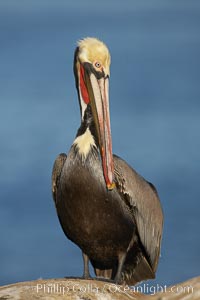
Brown pelican, winter plumage, showing bright red gular pouch and dark brown hindneck colors of breeding adults. This large seabird has a wingspan over 7 feet wide. The California race of the brown pelican holds endangered species status, due largely to predation in the early 1900s and to decades of poor reproduction caused by DDT poisoning.
Species: Brown Pelican, Pelecanus occidentalis, Pelecanus occidentalis californicus
Location: La Jolla, California
Image ID: 20097
Species: Brown Pelican, Pelecanus occidentalis, Pelecanus occidentalis californicus
Location: La Jolla, California
Image ID: 20097
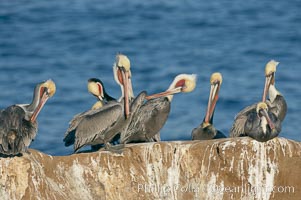
Brown pelican, non-breeding winter plumage. This large seabird has a wingspan over 7 feet wide. The California race of the brown pelican holds endangered species status, due largely to predation in the early 1900s and to decades of poor reproduction caused by DDT poisoning.
Species: Brown Pelican, Pelecanus occidentalis, Pelecanus occidentalis californicus
Location: La Jolla, California
Image ID: 20101
Species: Brown Pelican, Pelecanus occidentalis, Pelecanus occidentalis californicus
Location: La Jolla, California
Image ID: 20101
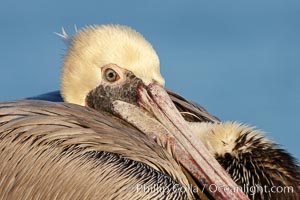
Brown pelican. This large seabird has a wingspan over 7 feet wide. The California race of the brown pelican holds endangered species status, due largely to predation in the early 1900s and to decades of poor reproduction caused by DDT poisoning. In winter months, breeding adults assume a dramatic plumage with brown neck, yellow and white head and bright red gular throat pouch.
Species: Brown Pelican, Pelecanus occidentalis, Pelecanus occidentalis californicus
Location: La Jolla, California
Image ID: 22145
Species: Brown Pelican, Pelecanus occidentalis, Pelecanus occidentalis californicus
Location: La Jolla, California
Image ID: 22145
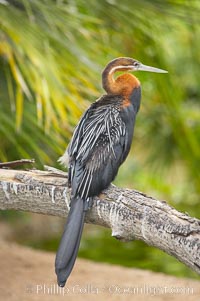
African darter. Darters are also known as snakebirds because they swim with only their heads and necks out of the water. A hinge mechanism at the birds eighth neck vertebra enables the bird to strike, snapping up insects on the water and stabbing fish. A stabbed fish is shaken loose, flipped up in the air and swallowed head first.
Species: African darter, Anhinga rufa rufa
Image ID: 12830
Species: African darter, Anhinga rufa rufa
Image ID: 12830
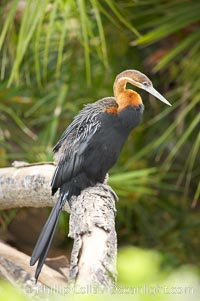
African darter. Darters are also known as snakebirds because they swim with only their heads and necks out of the water. A hinge mechanism at the birds eighth neck vertebra enables the bird to strike, snapping up insects on the water and stabbing fish. A stabbed fish is shaken loose, flipped up in the air and swallowed head first.
Species: African darter, Anhinga rufa rufa
Image ID: 12831
Species: African darter, Anhinga rufa rufa
Image ID: 12831
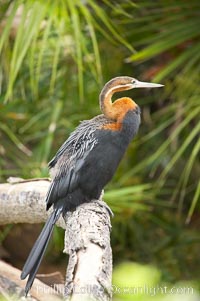
African darter. Darters are also known as snakebirds because they swim with only their heads and necks out of the water. A hinge mechanism at the birds eighth neck vertebra enables the bird to strike, snapping up insects on the water and stabbing fish. A stabbed fish is shaken loose, flipped up in the air and swallowed head first.
Species: African darter, Anhinga rufa rufa
Image ID: 12832
Species: African darter, Anhinga rufa rufa
Image ID: 12832
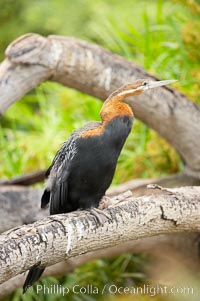
African darter. Darters are also known as snakebirds because they swim with only their heads and necks out of the water. A hinge mechanism at the birds eighth neck vertebra enables the bird to strike, snapping up insects on the water and stabbing fish. A stabbed fish is shaken loose, flipped up in the air and swallowed head first.
Species: African darter, Anhinga rufa rufa
Image ID: 12833
Species: African darter, Anhinga rufa rufa
Image ID: 12833
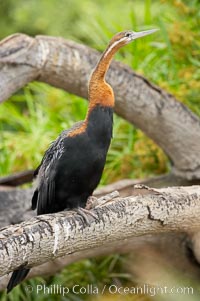
African darter. Darters are also known as snakebirds because they swim with only their heads and necks out of the water. A hinge mechanism at the birds eighth neck vertebra enables the bird to strike, snapping up insects on the water and stabbing fish. A stabbed fish is shaken loose, flipped up in the air and swallowed head first.
Species: African darter, Anhinga rufa rufa
Image ID: 12834
Species: African darter, Anhinga rufa rufa
Image ID: 12834
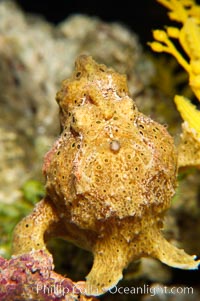
Frogfish, unidentified species. The frogfish is a master of camoflage, lying in wait, motionless, until prey swims near, then POW lightning quick the frogfish gulps it down.
Image ID: 14511
Image ID: 14511
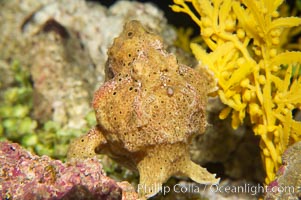
Frogfish, unidentified species. The frogfish is a master of camoflage, lying in wait, motionless, until prey swims near, then POW lightning quick the frogfish gulps it down.
Image ID: 14512
Image ID: 14512
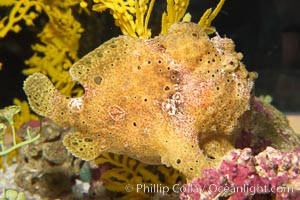
Frogfish, unidentified species. The frogfish is a master of camoflage, lying in wait, motionless, until prey swims near, then POW lightning quick the frogfish gulps it down.
Image ID: 14513
Image ID: 14513
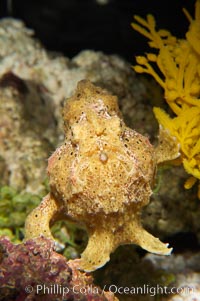
Frogfish, unidentified species. The frogfish is a master of camoflage, lying in wait, motionless, until prey swims near, then POW lightning quick the frogfish gulps it down.
Image ID: 14514
Image ID: 14514
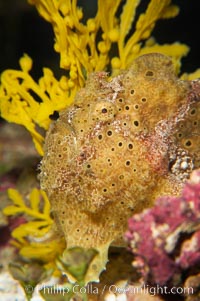
Frogfish, unidentified species. The frogfish is a master of camoflage, lying in wait, motionless, until prey swims near, then POW lightning quick the frogfish gulps it down.
Image ID: 14515
Image ID: 14515
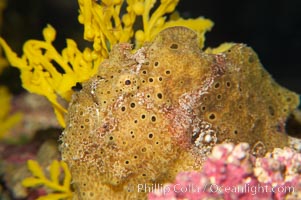
Frogfish, unidentified species. The frogfish is a master of camoflage, lying in wait, motionless, until prey swims near, then POW lightning quick the frogfish gulps it down.
Image ID: 14516
Image ID: 14516
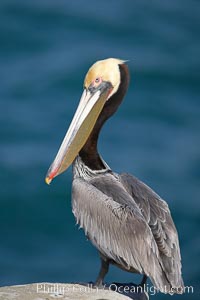
Brown pelican. This large seabird has a wingspan over 7 feet wide. The California race of the brown pelican holds endangered species status, due largely to predation in the early 1900s and to decades of poor reproduction caused by DDT poisoning. In winter months, breeding adults assume a dramatic plumage with brown neck, yellow and white head and bright red gular throat pouch.
Species: Brown Pelican, Pelecanus occidentalis, Pelecanus occidentalis californicus
Location: La Jolla, California
Image ID: 15129
Species: Brown Pelican, Pelecanus occidentalis, Pelecanus occidentalis californicus
Location: La Jolla, California
Image ID: 15129
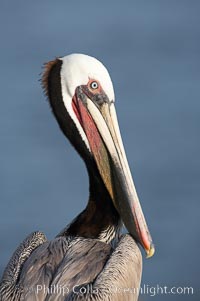
Brown pelican. This large seabird has a wingspan over 7 feet wide. The California race of the brown pelican holds endangered species status, due largely to predation in the early 1900s and to decades of poor reproduction caused by DDT poisoning. In winter months, breeding adults assume a dramatic plumage with brown neck, yellow and white head and bright red gular throat pouch.
Species: Brown Pelican, Pelecanus occidentalis, Pelecanus occidentalis californicus
Location: La Jolla, California
Image ID: 15175
Species: Brown Pelican, Pelecanus occidentalis, Pelecanus occidentalis californicus
Location: La Jolla, California
Image ID: 15175
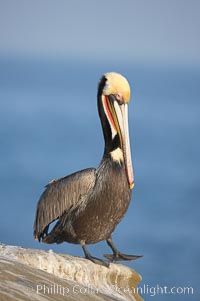
Brown pelican. This large seabird has a wingspan over 7 feet wide. The California race of the brown pelican holds endangered species status, due largely to predation in the early 1900s and to decades of poor reproduction caused by DDT poisoning. In winter months, breeding adults assume a dramatic plumage with brown neck, yellow and white head and bright red gular throat pouch.
Species: Brown Pelican, Pelecanus occidentalis, Pelecanus occidentalis californicus
Location: La Jolla, California
Image ID: 15190
Species: Brown Pelican, Pelecanus occidentalis, Pelecanus occidentalis californicus
Location: La Jolla, California
Image ID: 15190
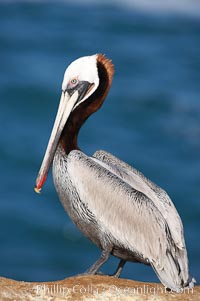
Brown pelican. This large seabird has a wingspan over 7 feet wide. The California race of the brown pelican holds endangered species status, due largely to predation in the early 1900s and to decades of poor reproduction caused by DDT poisoning. In winter months, breeding adults assume a dramatic plumage with brown neck, yellow and white head and bright red gular throat pouch.
Species: Brown Pelican, Pelecanus occidentalis, Pelecanus occidentalis californicus
Location: La Jolla, California
Image ID: 15208
Species: Brown Pelican, Pelecanus occidentalis, Pelecanus occidentalis californicus
Location: La Jolla, California
Image ID: 15208
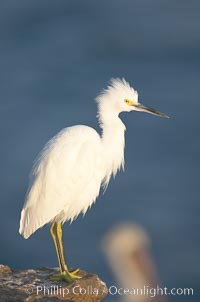
Snowy egret. The snowy egret can be found in marshes, swamps, shorelines, mudflats and ponds. The snowy egret eats shrimp, minnows and other small fish, crustaceans and frogs. It is found on all coasts of North America and, in winter, into South America.
Species: Snowy egret, Egretta thula
Location: La Jolla, California
Image ID: 15291
Species: Snowy egret, Egretta thula
Location: La Jolla, California
Image ID: 15291
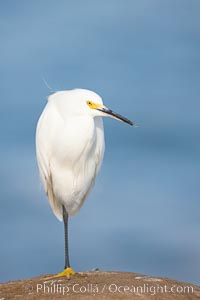
Snowy egret. The snowy egret can be found in marshes, swamps, shorelines, mudflats and ponds. The snowy egret eats shrimp, minnows and other small fish, crustaceans and frogs. It is found on all coasts of North America and, in winter, into South America.
Species: Snowy egret, Egretta thula
Location: La Jolla, California
Image ID: 15292
Species: Snowy egret, Egretta thula
Location: La Jolla, California
Image ID: 15292
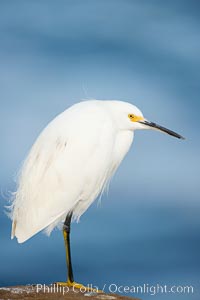
Snowy egret. The snowy egret can be found in marshes, swamps, shorelines, mudflats and ponds. The snowy egret eats shrimp, minnows and other small fish, crustaceans and frogs. It is found on all coasts of North America and, in winter, into South America.
Species: Snowy egret, Egretta thula
Location: La Jolla, California
Image ID: 15293
Species: Snowy egret, Egretta thula
Location: La Jolla, California
Image ID: 15293
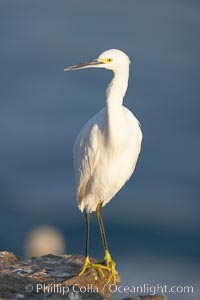
Snowy egret. The snowy egret can be found in marshes, swamps, shorelines, mudflats and ponds. The snowy egret eats shrimp, minnows and other small fish, crustaceans and frogs. It is found on all coasts of North America and, in winter, into South America.
Species: Snowy egret, Egretta thula
Location: La Jolla, California
Image ID: 15294
Species: Snowy egret, Egretta thula
Location: La Jolla, California
Image ID: 15294
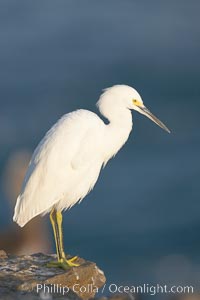
Snowy egret. The snowy egret can be found in marshes, swamps, shorelines, mudflats and ponds. The snowy egret eats shrimp, minnows and other small fish, crustaceans and frogs. It is found on all coasts of North America and, in winter, into South America.
Species: Snowy egret, Egretta thula
Location: La Jolla, California
Image ID: 15295
Species: Snowy egret, Egretta thula
Location: La Jolla, California
Image ID: 15295
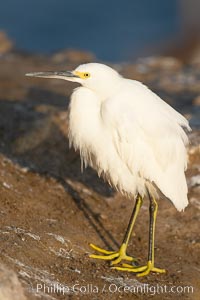
Snowy egret. The snowy egret can be found in marshes, swamps, shorelines, mudflats and ponds. The snowy egret eats shrimp, minnows and other small fish, crustaceans and frogs. It is found on all coasts of North America and, in winter, into South America.
Species: Snowy egret, Egretta thula
Location: La Jolla, California
Image ID: 15296
Species: Snowy egret, Egretta thula
Location: La Jolla, California
Image ID: 15296
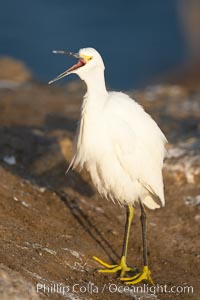
Snowy egret. The snowy egret can be found in marshes, swamps, shorelines, mudflats and ponds. The snowy egret eats shrimp, minnows and other small fish, crustaceans and frogs. It is found on all coasts of North America and, in winter, into South America.
Species: Snowy egret, Egretta thula
Location: La Jolla, California
Image ID: 15297
Species: Snowy egret, Egretta thula
Location: La Jolla, California
Image ID: 15297
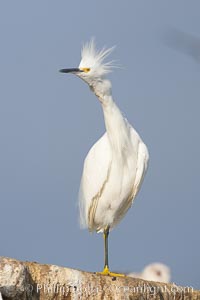
Snowy egret. The snowy egret can be found in marshes, swamps, shorelines, mudflats and ponds. The snowy egret eats shrimp, minnows and other small fish, crustaceans and frogs. It is found on all coasts of North America and, in winter, into South America.
Species: Snowy egret, Egretta thula
Location: La Jolla, California
Image ID: 15298
Species: Snowy egret, Egretta thula
Location: La Jolla, California
Image ID: 15298
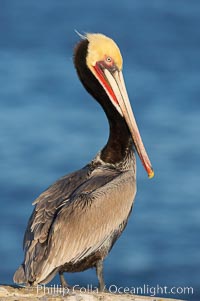
Brown pelican. This large seabird has a wingspan over 7 feet wide. The California race of the brown pelican holds endangered species status, due largely to predation in the early 1900s and to decades of poor reproduction caused by DDT poisoning. In winter months, breeding adults assume a dramatic plumage with brown neck, yellow and white head and bright red gular throat pouch.
Species: Brown Pelican, Pelecanus occidentalis, Pelecanus occidentalis californicus
Location: La Jolla, California
Image ID: 18043
Species: Brown Pelican, Pelecanus occidentalis, Pelecanus occidentalis californicus
Location: La Jolla, California
Image ID: 18043
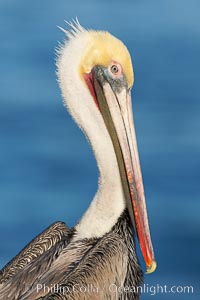
Brown pelican, adult winter non-breeding plumage showing white hindneck and red gular throat pouch.. This large seabird has a wingspan over 7 feet wide. The California race of the brown pelican holds endangered species status, due largely to predation in the early 1900s and to decades of poor reproduction caused by DDT poisoning.
Species: Brown Pelican, Pelecanus occidentalis, Pelecanus occidentalis californicus
Location: La Jolla, California
Image ID: 18046
Species: Brown Pelican, Pelecanus occidentalis, Pelecanus occidentalis californicus
Location: La Jolla, California
Image ID: 18046
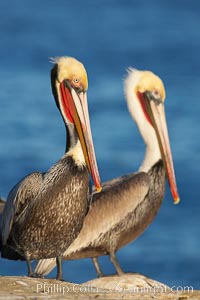
Brown pelicans, breeding plumage (left) and non-breeding adult (right), sunrise. This large seabird has a wingspan over 7 feet wide. The California race of the brown pelican holds endangered species status, due largely to predation in the early 1900s and to decades of poor reproduction caused by DDT poisoning. In winter months, breeding adults assume a dramatic plumage with brown neck, yellow and white head and bright red gular throat pouch.
Species: Brown Pelican, Pelecanus occidentalis, Pelecanus occidentalis californicus
Location: La Jolla, California
Image ID: 18048
Species: Brown Pelican, Pelecanus occidentalis, Pelecanus occidentalis californicus
Location: La Jolla, California
Image ID: 18048
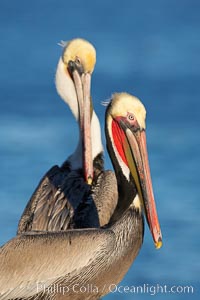
Brown pelican. This large seabird has a wingspan over 7 feet wide. The California race of the brown pelican holds endangered species status, due largely to predation in the early 1900s and to decades of poor reproduction caused by DDT poisoning. In winter months, breeding adults assume a dramatic plumage with brown neck, yellow and white head and bright red gular throat pouch.
Species: Brown pelican, Pelecanus occidentalis, Pelecanus occidentalis californicus
Location: La Jolla, California
Image ID: 18049
Species: Brown pelican, Pelecanus occidentalis, Pelecanus occidentalis californicus
Location: La Jolla, California
Image ID: 18049